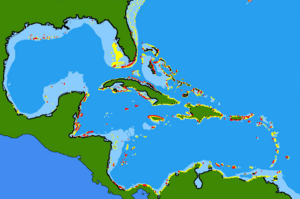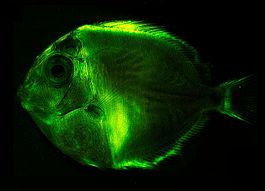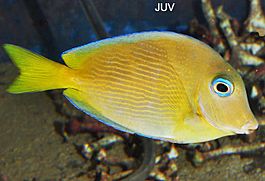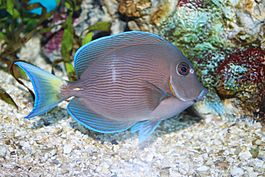Atlantic blue tang facts for kids
Quick facts for kids Atlantic blue tang |
|
|---|---|
 |
|
| Acanthurus coeruleus at San Salvador Island, Bahamas. The coral is Dendrogyra cylindrus. | |
| Conservation status | |
| Scientific classification | |
 |
The Atlantic blue tang (scientific name: Acanthurus coeruleus) is a colorful fish. It is a type of surgeonfish. You can find it often in the Atlantic Ocean. This fish can grow up to about 39 centimeters (15 inches) long.
People call it by many names. Some common names are blue tang, blue doctorfish, and yellow doctorfish.
Contents
Where Blue Tangs Live
Atlantic blue tangs are common in warm waters. You can find them off the coast of Florida and the Bahamas. They also live in the Caribbean Sea, including places like Bonaire and Belize. Their home range stretches from the Gulf of Mexico down to southern Brazil. They can even be found as far east as Ascension Island.
What Blue Tangs Look Like
Blue tangs can change their body color. They can be light blue or dark blue. Their top (dorsal), bottom (anal), and tail (caudal) fins are often golden blue.
When they are young, called juveniles, their fins have purple-blue, blue, or blue-green edges. The rings around their eyes are also these colors. As they grow, their colors change. Young blue tangs are yellow. Then they become yellow with a blue tail. Finally, as adults, they turn all blue.
Blue tangs can also glow! This is called biofluorescence. When blue or ultraviolet light shines on them, they glow green. This makes them look different than in regular light. Scientists think this glowing might help them talk to each other or hide.
How Blue Tangs Live
What Blue Tangs Eat
Atlantic blue tangs live in coral reefs. They also live in grassy and rocky areas near the shore. These places have lots of algae. Blue tangs are herbivores, which means they only eat algae.
They eat algae off the reefs. They also clean other fish by eating algae off their bodies. This makes blue tangs like little cleaners for other fish!
Young blue tangs eat all the time. They need to eat a lot because their bodies are not very good at using all the food. Their stomachs are good at breaking down cells, but not good at processing tough plant parts like cellulose. Because of this, they spend a lot of time eating. Luckily, algae grows fast and is easy to find nearby.
Cleaning Other Animals
Atlantic blue tangs help other animals by cleaning them. They remove tiny creatures called parasites and other unwanted things from the skin of other fish. This helps the other animals stay healthy.
- Blue Tangs as Cleaners: Blue tangs eat algae, shed skin, and parasites off other animals. A common animal they clean is the green turtle. The blue tang will nip at the turtle's head, legs, tail, and shell to clean it.
- Blue Tangs as Clients: Blue tangs also get cleaned by other fish. They often go to "cleaning stations" where cleaner gobies live. The gobies clean the blue tangs' fins. Blue tangs have sharp spines on their tails, so the cleaners must be careful!
When a blue tang wants to be cleaned, it will "pose." This means it will stand on its head. Fish that pose are more likely to get cleaned.
Healing Wounds
Cleaning helps blue tangs heal from injuries. Blue tangs often get small injuries. But they rarely die from infections. They recover very well from both small and big injuries.
Injured blue tangs spend more time at cleaning stations. This shows that cleaning is important for them to get better. The cleaner fish pick at the wound and eat dead skin around it.
How Blue Tangs Act Together
Blue tangs act in three main ways:
- Territorial: Some blue tangs claim a specific area as their home. They are aggressive and chase away other blue tangs that come into their space. They swim slower and eat more often. These blue tangs are usually found in sandy areas with rocks or coral.
- Schooling: Other blue tangs form groups called schools. They swim fast and eat at a medium rate. They are not aggressive, even if other fish chase them. Schooling is common in areas with many other fish, like the groove zone or crest zone of a reef. Schools are most common around midday.
- Wandering: Wandering blue tangs move around freely. Other fish often chase them. They also visit cleaning stations more often. Wandering is most common in the morning and in areas with mixed algae, rock, and sand.
When there are more blue tangs in an area, individuals tend to become more territorial. Young blue tangs are often territorial. But as they get older and bigger, they tend to school or wander more.
Young Blue Tang Behavior
Young blue tangs act differently from adult blue tangs. They usually stay by themselves in their own small areas. The size of their home area grows as they get bigger. These areas often overlap with the territories of other fish called damselfish. Young blue tangs are aggressive in defending their space. They try to avoid damselfish and are rarely chased by them.
Blue Tangs and People
Atlantic blue tangs are not in danger from humans. People catch them for commercial fishing, but they are not a very important fish for the fishing industry. Sometimes, they are used as bait. They are also popular in home aquariums.
This fish does not have a high value for food because it can smell very strong. If you eat the meat, you might get Ciguatera poisoning, which can make you sick.
The adult blue tang has a sharp spine on its tail. This spine only comes out when the fish is excited or scared. These spines can cut human skin deeply. The cuts can get infected, causing swelling and discoloration. The pain can last for many hours. Some types of surgeonfish are even thought to have poison glands on their tail spines.
See also
 In Spanish: Pez cirujano para niños
In Spanish: Pez cirujano para niños







